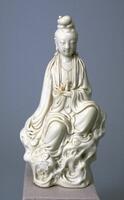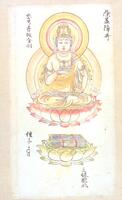15 UMMA Objects
15 UMMA Objects

Chinese (Chinese (culture or style))
The Bodhisattva Guanyin
19th century
Gift of Willard A. and Marybelle Bouchard Hanna
1991/2.23
![<p>This bowl has a narrow foot and a ared mouth. is type of bowl was produced in large quantities from the 11th century to the 12th century. Its inner wall has mold-impressed peony sprays. The entire body of the bowl is glazed, including the inside of the foot, but the glaze on its rim of the foot was wiped away, on which refractory spurs were adhered to for ring. Parts of the inner surface show ne crackles, while the inner bottom was stained with greenish-brown iron spots. One part of the rim was damaged and subsequently repaired. Glaze applied to the outer surface has partially owed downwards, resulting in an uneven surface, but the glaze and clay are quite well fused and sintered.<br />
[<em>Korean Collection, University of Michigan Museum of Art</em> (2014) p.93]</p>
<br />
The celadon bowl has straight-lined sides. The surface is evenly coated with a dark bluish green glaze. The celadon bowl rests on a rather tall foot, which was hollowed out from the bottom. The designs are present only on the inside <p>This bowl has a narrow foot and a ared mouth. is type of bowl was produced in large quantities from the 11th century to the 12th century. Its inner wall has mold-impressed peony sprays. The entire body of the bowl is glazed, including the inside of the foot, but the glaze on its rim of the foot was wiped away, on which refractory spurs were adhered to for ring. Parts of the inner surface show ne crackles, while the inner bottom was stained with greenish-brown iron spots. One part of the rim was damaged and subsequently repaired. Glaze applied to the outer surface has partially owed downwards, resulting in an uneven surface, but the glaze and clay are quite well fused and sintered.<br />
[<em>Korean Collection, University of Michigan Museum of Art</em> (2014) p.93]</p>
<br />
The celadon bowl has straight-lined sides. The surface is evenly coated with a dark bluish green glaze. The celadon bowl rests on a rather tall foot, which was hollowed out from the bottom. The designs are present only on the inside](/media/W1siZiIsIjIwMjIvMDkvMjQvOWpqdXU4d2plel9kZWZhdWx0LmpwZyJdLFsicCIsInRodW1iIiwiMjQweDIwMCJdXQ?sha=d6b4e1202cb44ca4)
Korean (Korean (culture or style))
Conical bowl with molded floral design
12th century
Gift of Bruce and Inta Hasenkamp and Museum purchase made possible by Elder and Mrs. Sang-Yong Nam
2004/1.222
![<p>The cup has a mouth that curves slightly inwards; this is a form typical of round cups with saucers produced in large numbers in the 13th and 14th centuries. The cup is decorated only on the outer rim with a fret-patterned band. Repaired damage is visible on several parts on the mouth, as well as cracking that occurred during ring. Glaze has been applied down to the foot, and three quartzite spur marks remain on the outer base. The partially oxidized body displays darker patches on the surface, but it preserves a bright celadon color overall.<br />
[<em>Korean Collection, University of Michigan Museum of Art </em>(2014) p.120]</p>
The celadon cup has a mildly inverted rim with curved sides that are bent once, at a sharp angle, near the base. The surface is coated with a greenish blue glaze. The slightly inward-turning mouth facilitates drinking while the sides curve gently toward the base. <p>The cup has a mouth that curves slightly inwards; this is a form typical of round cups with saucers produced in large numbers in the 13th and 14th centuries. The cup is decorated only on the outer rim with a fret-patterned band. Repaired damage is visible on several parts on the mouth, as well as cracking that occurred during ring. Glaze has been applied down to the foot, and three quartzite spur marks remain on the outer base. The partially oxidized body displays darker patches on the surface, but it preserves a bright celadon color overall.<br />
[<em>Korean Collection, University of Michigan Museum of Art </em>(2014) p.120]</p>
The celadon cup has a mildly inverted rim with curved sides that are bent once, at a sharp angle, near the base. The surface is coated with a greenish blue glaze. The slightly inward-turning mouth facilitates drinking while the sides curve gently toward the base.](/media/W1siZiIsIjIwMjIvMDkvMjQvMmRjZTRvbXNlel9kZWZhdWx0LmpwZyJdLFsicCIsInRodW1iIiwiMjQweDIwMCJdXQ?sha=b6f3e998b597b135)
Korean (Korean (culture or style))
Wine cup with incised patterns
1100 – 1299
Gift of Bruce and Inta Hasenkamp and Museum purchase made possible by Elder and Mrs. Sang-Yong Nam
2004/1.225
![<p>This is an intact hair oil bottle; an invaluable source for the information it provides about the form of Goryeo celadon oil bottles. The foot was made by removing the clay from the bottom of the base, while the foot rim shows the trase of glaze having been wiped away and has small grains of sand ahered to it. Glaze was oxidized in parts, yielding a yellow-brown color, and fine crackles are formed on the glazed furace. Glaze was poorly fused and there are glaze runnings on the lower part of the body.<br />
[<em>Korean Collection, University of Michigan Museum of Art</em> (2014) p.129]</p>
<p>This is an intact hair oil bottle; an invaluable source for the information it provides about the form of Goryeo celadon oil bottles. The foot was made by removing the clay from the bottom of the base, while the foot rim shows the trase of glaze having been wiped away and has small grains of sand ahered to it. Glaze was oxidized in parts, yielding a yellow-brown color, and fine crackles are formed on the glazed furace. Glaze was poorly fused and there are glaze runnings on the lower part of the body.<br />
[<em>Korean Collection, University of Michigan Museum of Art</em> (2014) p.129]</p>](/media/W1siZiIsIjIwMjIvMDkvMjQvMTF3MHdzMzRjc19kZWZhdWx0LmpwZyJdLFsicCIsInRodW1iIiwiMjQweDIwMCJdXQ?sha=230528ea44a1924d)
Korean (Korean (culture or style))
Small Oil Bottle
1133 – 1166
Gift of Bruce and Inta Hasenkamp and Museum purchase made possible by Elder and Mrs. Sang-Yong Nam
2004/1.237

Chinese (Chinese (culture or style))
Bodhisattva Guanyin
7th century
Museum purchase for the James Marshall Plumer Memorial Collection
1964/2.81
![The vase has a slightly outward-turned rim and a short neck. The elegantly-shaped bottle flares out to a broad shoulder, then tapers gradually to a slim waist before flaring out once more at the base. The shoulder, mid-belly and base of the vase are decorated with black and white clay-inlaid cloud, crane and butterfly motifs.
<p>The body of this vase is inlaid with clouds with black slip and butterflies inlaid with black and white slips, while the lower body is decorated with incised fret-patterned band. The mouth has been completely destroyed and repaired once, but has now fallen into decay. The glaze at the foot is opaque and cracked because of the low ring temperature and it has many pinholes on one side. Glaze was wiped away from the base, and there remain refractory spur marks.<br />
[<em>Korean Collection, University of Michigan Museum of Art</em> (2014) p.137]</p>
The vase has a slightly outward-turned rim and a short neck. The elegantly-shaped bottle flares out to a broad shoulder, then tapers gradually to a slim waist before flaring out once more at the base. The shoulder, mid-belly and base of the vase are decorated with black and white clay-inlaid cloud, crane and butterfly motifs.
<p>The body of this vase is inlaid with clouds with black slip and butterflies inlaid with black and white slips, while the lower body is decorated with incised fret-patterned band. The mouth has been completely destroyed and repaired once, but has now fallen into decay. The glaze at the foot is opaque and cracked because of the low ring temperature and it has many pinholes on one side. Glaze was wiped away from the base, and there remain refractory spur marks.<br />
[<em>Korean Collection, University of Michigan Museum of Art</em> (2014) p.137]</p>](/media/W1siZiIsIjIwMjIvMDUvMjUvZWRiaGFnd2pvX2RlZmF1bHQuanBnIl0sWyJwIiwidGh1bWIiLCIyNDB4MjAwIl1d?sha=311f4bfb4608e381)
Korean (Korean (culture or style))
Maebyeong (wine storage jar) with design cranes, butterflies, & stylized clouds
12th century
Transfer from the College of Architecture and Design
1972/2.80

French (French (culture or style))
Relief Panel with the Lamb of God ("Agnus Dei")
1133 – 1166
Lent by Dumbarton Oaks, Washington, D.C.
LTL1985.49

Takuma Tametō
Bodhisattva (Jokaisho Bosatsu): esoteric Buddhist iconographic drawing
1133 – 1166
Museum purchase made possible by the Margaret Watson Parker Art Collection Fund
1963/1.99

Chinese (Chinese (culture or style))
Bodhisattva Avalokitesvara (Chinese, Guanyin) with a willow branch and vase
618 – 907
Gift of Mrs. Caroline I. Plumer for the James Marshall Plumer Collection
1964/2.20

Chinese (Chinese (culture or style))
Bodhisattva Avalokitesvara (Chinese, Guanyin), seated in a posture of royal ease
1368 – 1644
Museum purchase made possible by the Margaret Watson Parker Art Collection Fund
1972/2.43
Loading…


